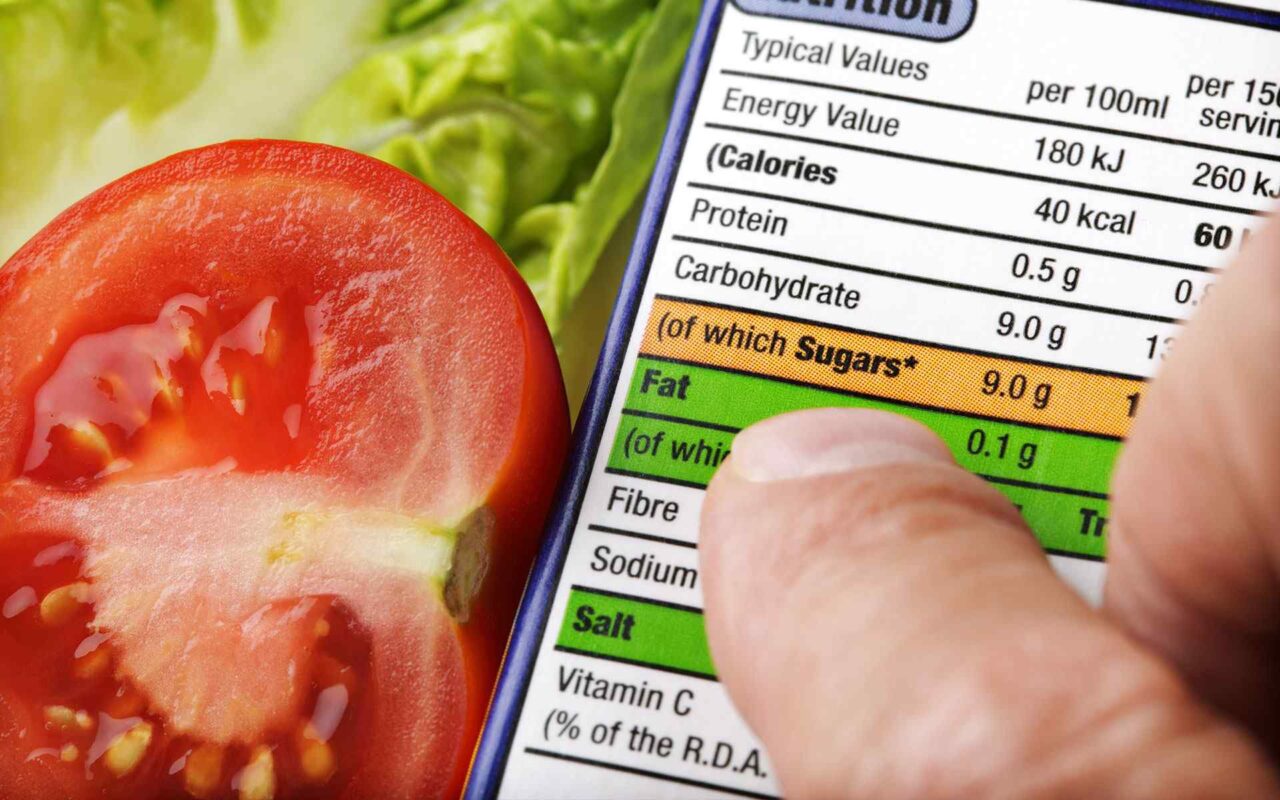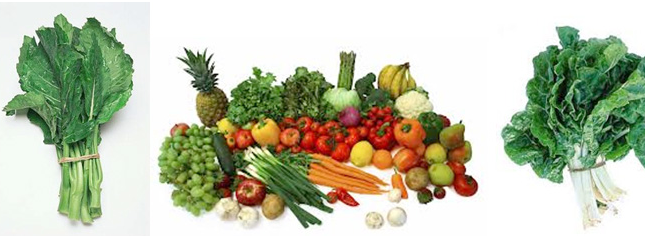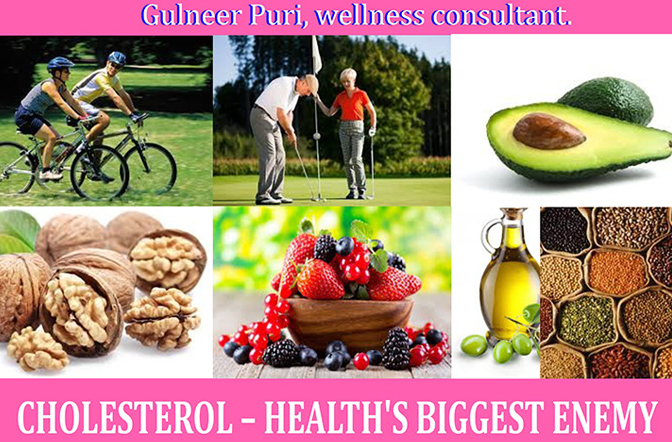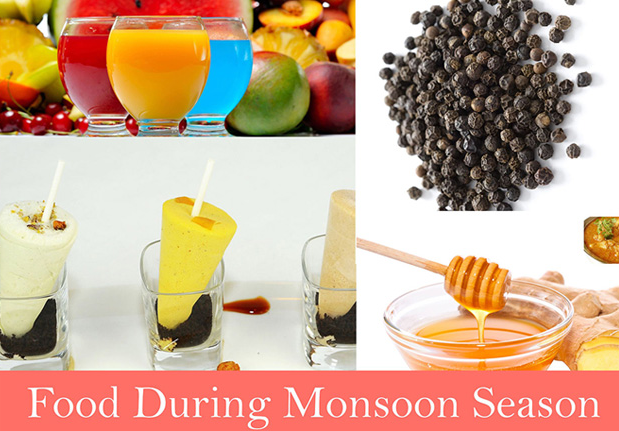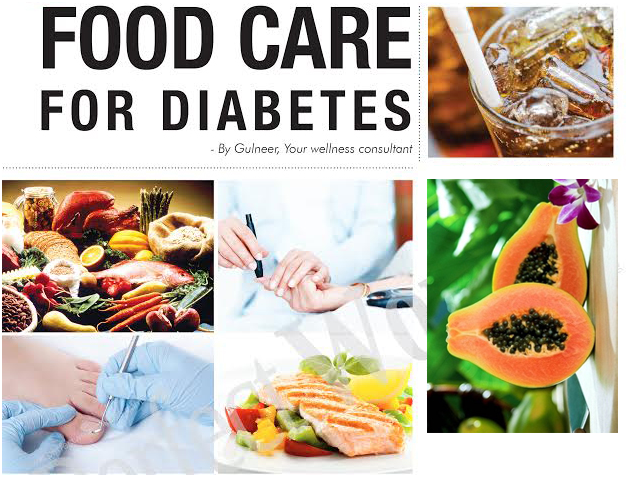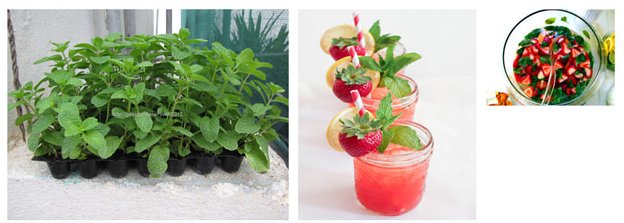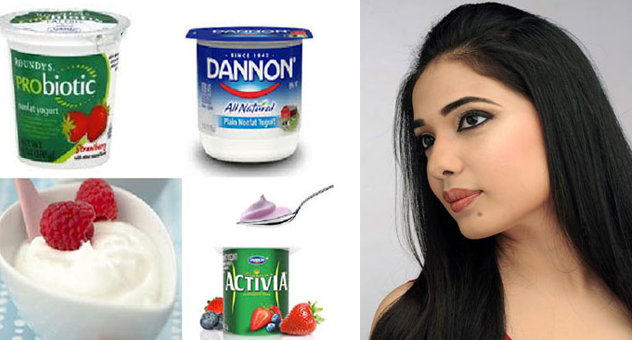Veggies es bonus vobis, proinde vos postulo essum magis kohlrabi welsh onion daikon amaranth tatsoi tomatillo melon azuki bean garlic. Gumbo beet greens corn soko endive gumbo gourd. Parsley shallot courgette tatsoi pea sprouts fava bean collard greens dandelion okra wakame tomato.
Blog
Winter is a time to get into warm snuggle clothes. Though it is colder outside and we need extra calories to stay warm. Amazingly, the body engine works better in winter and food is better digested. Every one tends to feel hungry. Any vegetable that takes time to grow, and in which the edible part grows beneath the surface is warming and a good vegetable to grow in winters. Root vegetables make excellent winter choices. It is the best time to improve ones immunity.
Dates are warm in nature and are highly recommended in the winter months. I would suggest having at least 2 dates everyday during winter season. They are good source of fiber, iron, magnesium, calcium and B vitamins. Since they are sweet in nature, they are also a good source of energy. Among spices mustard, ajwain (carom seeds) are valuable remedy for winter coughs and flu, stimulating appetite and digestion and increasing blood circulation. Methi (fenugreek seeds) dry or sprouted is beneficial in bone and joint problems that surface more in winters.
All animal foods fall into the warming category, including lean dairy, meat, fish and poultry. The most warming vegetables that are good for your body are root vegetables like carrot, potato, onions, garlic, radish, yams, sweet potato, beet root and winter greens like palak (spinach), methi, sarson (mustard green), radish leaves, pudina (mint) etc.
During evening hours in winter our dinner table is full of exciting colorful fruits and vegetable salad, which are mouth watering and increases one’s appetite and also promotes with over all wellness. In this months column, I would like to share few salad recipes with their calorie count to be eaten for lunch or dinner time or even as a appetizer before dinner to curb your hunger pangs so that one does not munch too much into junk food.
CHICKPEA SALAD
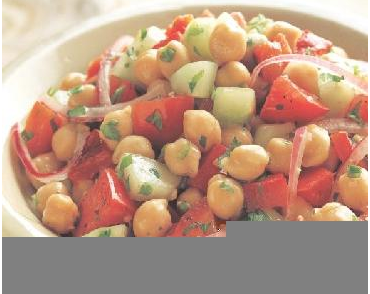
It has been researched that chick-pea diet can significantly slash bad LDL cholesterol levels. Reap the benefits of this refreshing salad.
PREP TIME :15 minutes
TOTAL TIME : 25 minutes
Serving : 8
- 1 can chick peas, rinsed and drained or chickpeas soaked over night and steamed in pressure cooker
- ½ small red onion, quartered and thinly sliced.
- ½ cucumber, peeled, seeded and chopped
- 1 roasted red pepper, chopped
- 3 plum tomatoes, chopped
- 2 Tbsp chopped parsley
- 2 clove garlic, chopped
- 3 tbsp lemon juice
- 2 tsp extra-virgin olive oil
- ¼ tsp salt
Combine all ingredients in large bowl. Toss to mix. Allow it to stand at room temperature for 10 minutes for flavors to blend.
NUTRITION
(per servings) 80 Cal, 3 gms protein, 14 gms carbs, 3 gms fiber, 1.8 gms fat, 0.2 gms saturated fat, 213 mg sodium.
CHICKEN AVOCADO SALAD
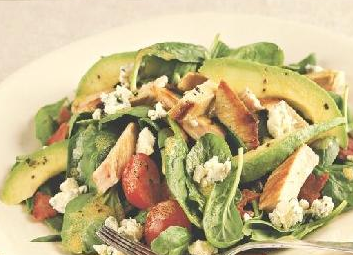
This salad makes healthy meat lovers delight.
Ingredients
PREP Time : 8 mins
TOTAL TIME : 15 mins
SERVINGS : 4
- 1 lb chicken breast cutlets
- 1 Tbsp olive oil
- ¼ tsp salt
- 2 tbsp cider vinegar
- 1 tsp Dijon miustard
- 8 cups baby spinach leaves
- ½ ripe avocado, cut into ½” cubes
- 4 cherry tomatoes, halved
- PREHEAT grill pan on medium high heat for 2 minutes. Brush chicken with 1 tsp of the oil and sprinkle with half of the salt. Grill chicken 4 minutes, flip and continue cooking until centers are opaque and juices run clear, about 3 minutes longer. Cut into chunks.
- TO PREPARE THE DRESSING: Combine vinegar, mustard, 1 tbsp of water and remaining 2 tsp of oil and 1/8 tsp salt in glass jar. Shake well.
- TOSS spinach with2 tablespoon of the dressing in large bowl. Arrange chicken, avocado, tomatoes and cheese over spinach. Drizzle remaining dressing over salad and season with black pepper to taste.
Nutrition (per serving) 270 Calorie, 34 gm protein, 10 gm carbs, 5 gms fiber, 13.4 g fat
GRAPEFRUIT AVOCADO SALAD WITH SHERRY DRESSING
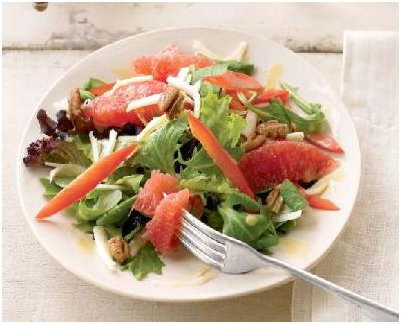
Ingredients
PREP Time : 20 mins
TOTAL TIME : 20 mins
SERVINGS : 4
- 1 Tbsp olive oil
- 1 Tbsp medium dry sherry or sherry vinegar
- 1 ½ tsp red wine vinegar
- ¼ tsp salt
- 1/8 tsp freshly ground pepper
- 1 pink grapefruit
- 4 cup colorful mixed baby greens
- 1 cup ripe avocaods
- 2 Tbsp chopped onions
- Mix the oil, sherry or sherry vinegar, red wine vinegar, salt and pepper in a salad bowl with a fork.
- Use a serrated knife to peel the grapefruit, cutting off most, but not all, of the white pith. Working over bowl, cut out the fruit from between the membranes. Add 1 ½ tbsp. of grapefruit juice to the dressing and mix well.
- Add the greens avocado, red onions, and grapefruit sections to the dressing and toss gently to mix. Serve immediately.
NUTRITION (PER SERVING) 154 Cal, 2 gm protein, 19 gms carbs, 6 gm fiber, 9.2 gm sat fat
SALMON SALAD

A tangy mix of balsamic vinegar, Dijon mustard and sun dried tomatoes pair nicely with salmon for this omega-3-filled delight.
PREP Time : 15 mins
TOTAL TIME : 26 mins
SERVINGS : 4
Ingredients
- 3 Tbsp chopped dry-pack sun-dried tomatoes
- 3 Tbsp balsamic vinegar
- 2 tsp extra virgin olive oil
- 1 ½ tsp dried basil
- 1 tsp Dijon mustard
- 1/8 tsp salt
- 1 roasted red pepper, cut into small strips
- 4 oz button mushrooms sliced
- 1 small onions, minced
- 4 salmon fillet (3 oz each), skin removed
- 1 tsp Italian dressing
- Place the sun dried tomatoes in a small bowl. Cover with boiling water. Allow to soak for 10 minutes or until soft. Drain and discard the liquid.
- Whisk the vinegar, oil, basil, mustard and salt in a large bowl until smooth. Place the pepper and sun dried tomatoes and greens in the bowl but do not toss. Set aside.
- Coat a medium non stick skillet lightly with non stick spray. Add the mushrooms and onion. Coat lightly with non stick spray. Cook over medium high heat for 5-7 minutes, or until soft. Remove to a plate to cool.
- Wipe the skillet with a paper towel. Coat with non stick spray. Set over high heat. Lightly coat the salmon with non stick spray. Sprinkle with the Italian seasoning. Add the salmon to the skillet. Cook for 3 minutes on each side, or until the fish flakes away easily.
- Add the mushrooms and onion to the reserved bowl. Toss to mix. Spoon the salad onto 4 plates. Top each with a salmon fillet.
NUTRITION (PER SERVING) 236 Cal, 21 gm protein, 12 gms fiber, 12.1 gm fat, 2.3 gms sat fat.
TOASTED ALMOND CHICKEN SALAD
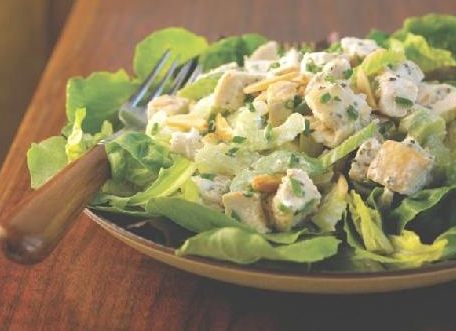
Chives from your garden and crunchy almonds lend spice and crunch to this delicious dinner salad.
PREP Time : 20 mins
TOTAL TIME : 1 hr, 20 minutes
SERVINGS : 4
Ingredients
- 3 sm chicken breast halves
- 3 ribs celery, sliced
- 1 bunch chives, finely chopped
- ½ cup low fat plain yogurt
- ¼ cup light sour cream
- 2 tbsp silvered almonds, toasted
- salt to taste
- Ground black pepper
- 1 bag mixed greens
- Coat a nonstick skillet with cooking spray and place over medium high heat. When it is hot, add the chicken and cook for 4 minutes per side, or until the juices run clear. Remove the chicken from heat and let it rest for at least 10 minutes. When they are cool, chop the chicken breast into pieces.
- Combine the chicken, celery, yogurt, sour cream in a large bowl. Mix lightly
- Cover and refrigerate for at least 1 hour. Add the almonds and salt and pepper to taste. Serve on a bed of greens.
177 Cal, 25 gms protein, 8 gms carbs, 3 gms fiber, 5 gms fat, 1.7 gms sat fat.
For any health related query, e-mail the writer at info@wellnessbeyonddiet.com
She can also be contacted at 08427162181
Gas and bloating are very uncomfortable conditions, which every women goes through at all age group and it becomes trouble some once women reach their 30’s and are unable to take time out for exercise. Having being travelled to different cities within India, America and United Kingdom, I heard many people complaining of bloating stomach. This happens due to wrong combination of food we eat and our enzymes within our body are unable to digest them.
However it is not possible to have a perfect flat stomach all the time. After we eat and drink any kind of food or liquid, it takes up space inside our intestines that leads to expansion. A ballooned belly does not mean that something is wrong with what we eat, but if our abdomen is too swollen to squeeze into your jeans, you may like to identify belly bloater in your diet.

Cruciferous vegetables
Cruciferous vegetables are spinach, kale, broccoli and cabbage, which contain raffinose – a sugar that remains undigested until bacteria in your gut ferments it, which produces gas and makes you bloat. These are nutrient dense vegetables, which should not be avoided from your diet. So one can steam them and also should keep an eye on the portion sizes. Cooking these vegetables softens the fiber and shrinks the portion, as some of the water cooks out, so it takes less space in the GI tract. It will not eliminate or prevent bloating all together, but will help in making your veggies easier to digest.
Beans
Another food item is beans, along with lentils. Soya beans are gas-causing food. These small buds are burst of proteins but they also contain sugar and fiber that our body can’t absorb. When legumes enter large intestines, gut bacteria feeds on them. This process leads to gas and our waist gets enlarged like a balloon.
Legumes
I would recommend to combine legumes with easily digestible whole grains like rice or quinoa. You can also well combine them with fruits, vegetables, nuts or whole grain as they would not bother you as much as you eat them sporadically.
Milk and Milk Products
After drinking milk or eating milk products, you might feel bloated or gassy. This may be because you are lactose intolerant, which means that body lacks necessary enzymes to break down lactose. This can cause the gas to form in the GI tract. You can also opt for lactose free or non-dairy alternative. The American gastroenterological Association (AGA) also suggests use of lactose tablets like lactaid, which helps people digest food that contains lactose.
High Sodium Diet
Eating high sodium food can trigger water retention. Avoiding sodium is not as simple as steering clear of salt-shaker.
It is very surprising when I talk about apples. These are great snacks. This fruit is high in fibers and also contains fructose and sorbitols. One fruit provides with an average of 4.5 grams of proteins and around 10% of your daily Vitamin C. So one should not give up on them totally. Eat them in moderation and separately from meals.
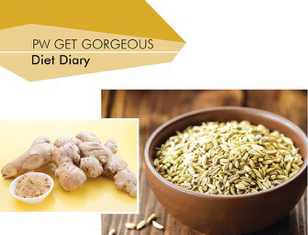

Cholesterol is one of the leading health problems in India. Few of the high cholesterol risk factors such as family history and age can’t be controlled. How ever, many life style choices can be changed to lower it. Reducing your stress is also a key factor in maintaining a healthy lifestyle. Every one, today is caught up in materialistic modern life, to reach working deadlines, family needs and household responsibility – perhaps in buying a house or even looking into academics of children, to make sure they are faring well and progressing towards the right path in life. During stressful time, chemical messengers are released. If you over eat, smoke or turn into a couch potato in response to high anxiety, you are giving into unhealthy lifestyle habits that can raise level of LDL’s and also erode level of HDL’s. One such theory is, stress hormone increases the fuel available to the body by flooding it with glucose while at the same time inhibiting insulin production. This then prevents cortisol from being stored and instead encourages it to be used immediately. But if this energy is not used because we are not physically active then it may build up eventually leading to the formation of fat tissues and eventually cholesterol in arteries.
One can get into many activities to manage your stress, such as going out for walk or joining a gym, involving into few of the yoga exercises, practicing deep breathing exercises, talking to a
friend, practicing time management and above all changing one’s diet to bring in a complete life style change.
Eat Heart Healthy diet
To lower cholesterol eating a dietary pattern that emphasis on fruits, vegetables, whole grains, low fat dairy products, poultry, fish and nuts. Red meat along with sugary food and beverages should also be limited. Saturated fats found in red meat and dairy products raise your total cholesterol and also the bad cholesterol especially LDL. Look in for leaner cuts of meat, low fat dairy (skim or double toned milk). Food higher in polyunsaturated fat (PUFA) include a number of plant based oil as well as fatty fish such as salmon, mackerel, herring and trout. Other sources include some nuts and seeds such as walnuts and sunflower seeds, tofu and soya beans. Many diet fit that pattern including DASH – DIETARY APPROACHES TO STOP HYPERTENSION. This can be easily adapted based on your cultural and food preferences.
Get Moving
Being physically active is also important to prevent heart disease and stroke. 40 minutes of aerobic exercise of moderate to vigorous intensity done 3-4 times a week is enough to lower both cholesterol and high blood pressure. Brisk walking, swimming and bicycling are few good examples. To stay motivated, find an exercise friend or join an exercise group. Any kind of activity is helpful. Even taking the stairs instead of elevator or doing few sit-ups can also make a difference.
Legumes
I would recommend to combine legumes with easily digestible whole grains like rice or quinoa. You can also well combine them with fruits, vegetables, nuts or whole grain as they would not bother you as much as you eat them sporadically.
Include Soluble Fiber
There are two types of fiber soluble and insoluble. Both are considered heart healthy. But soluble fiber gets solubilized in the blood and lowers your LDL level. It also helps to lower sugar levels in diabetes. Add soluble fiber to your diet by eating oats in breakfast and adding oat bran to your meal. Lentils and whole fruits along with peels are good examples of soluble fibers
Add whey Protein
Whey protein is one of the two proteins in dairy products. It is the left over translucent water in making cottage cheese (paneer). Whey protein may account for many of the health benefits attributed to dairy. For better results one can also add oat bran to the whey water.
Quit Smoking
Quitting, improves your HDL cholesterol level. It has been observed that within 20 minutes of quitting, your blood pressure and heart rate decreases. Within one year your risk of heart disease is half than that of a smoker. Within 15 years, your risk of heart disease is similar to some one who never smoked.
Lose Weight
Carrying even a few extra pounds contributes to higher cholesterol. Losing 5-10% of your weight can also improve cholesterol level. Start by evaluating your eating habits and daily routine. Consider your challenges to weight loss and try to over come them. Small changes help, if you are busy in your work schedule and don’t have time to prepare your meal, pack some thing healthier for home. For snack munch on carrot sticks, seasonal fruits and berries or air popped popcorns instead of potato chips and look for ways to incorporate more activities into your daily routine.
I feel eating right diet is like a bank account. Good food choices are good investments for over all well-being of every individual.
After a blow of hot dry summer months, when the monsoons come in we receive a sigh of relief from scorching heat. While there is cool breeze in the air, our eyes pop out for fried fritters (Pakoras, samosas, kachori). At the same time rains may bring with it a series of infection and occasional flu. It is this time, when people start facing allergy problems, running nose, skin related issue, itchy and watery eyes are few of the allergies heard of during monsoon phase. Damp and filthy conditions in monsoon play a host for many disease-causing germs, which cause serious health issues. Malaria, Typhoid, Hyphae and conjunctivitis are some of the frequent health problems faced by many people. We feel bloated most of the time and always complain of loss of appetite. Water available in the reservoir during monsoon is comparatively heavy to digest and the metabolism is sluggish. Under such circumstances, Ayurveda describes aggravation (vitiation) of vata and accumulation of Pita in rainy days. Space, air, water, fire and earth called the pancha mahabhootas (five primordial elements) from our body and souls, controlling these elements are three doshas – vata (denoting movements), Pitta (denoting transformation) and kapha (denoting stability), which helps maintain equilibrium. The monsoon season sees a rise in vata, which has properties of coolness and lightness. This increase causes dryness in the body and an imbalance in secretion of digestive juices, thereby compromising our metabolism.
Depending upon the constitution of an individual’s body, it may have no effect or as generally observed it can result in everything from joint pain and muscle weakness to flatulence. To control vata as well as combat its effect on our health, Ayurveda recommends that you consume and avoid certain foods.
- Drink warm beverages : add mint or ginger or dry ginger powder to tea.
- Moon dal is easier to digest: Garlic, pepper, ginger, asafoetida, turmeric, coriander and cumin enhances your body’s digestive power and improves immunity.
- Vegetables recommended during rainy days would be okra (bhindi), bottle Guard (dudhi), brinjal (roasted baigan), bitter gourd (kerela). Fruits include Pomegranate, bananas and berries are ideal for monsoon. Include a couple of dates everyday for iron and energy requirements.
- Non vegetarian should include lighter meat preparation like soups and stews Rather than heavy curries.
- Over all astringent, mildly bitter and mildly pungent food work best in Monsoon season. 6. Drink boiled water and its variant.
- Make a ginger paste with a pinch of rock salt, hint of lemon and sugar to taste and eat it before each meal or at least before breakfast. One can also include thin slices of ginger in your meal.
- Rum and sweet red wine are ideal replacements for alcohol like beer & gin.
Finally garlic petals greatly aid digestion and controls vata and dosha.
Food to be Avoided:
- Avoid eating food outside during rainy season. Avoid fish and prawns (sea food) during monsoon, as it is their breeding time.
- Always keep in mind that vegetables you purchase are fresh. It is advisable to buy vegetables for every two days instead of buying for the whole week.
- Fried fritters, be it in any form as pakoras, kachori/samosa, chat, indo-chinese leafy vegetables and sea-food.
- Oils : Heavy oils like mustard and sesame should be avoided during monsoon as they render the body vulnerable to infection. Oils used for cooking during the monsoon season are dry oil like corn or light oils like olive oil.
- Ice from non-distilled water, kulfis and golas should be avoided.
- Juices and cut fruits available at the vendors should be avoided and fruits should be eaten fresh to avoid all kinds of contamination.
- From our toddler days to late teens, we have been instructed by our mothers about the importance of eating green leafy vegetables. But during monsoon season they are best avoided because the dampness, dirt and mud present in the leaves make them susceptible to many germs, leading to different stomach infections.
- Aerated Drinks These drinks reduce minerals in our body, which in turn lead to reduction of enzyme activity. This leads to weak digestive system. Always keep a bottle of water or lemon green tea handy.
- Individuals who suffer with skin allergies during monsoons must avoid spicy Food as this raises body’s temperature and stimulates blood circulation and leads to allergies and skin irritations.
The food aid lifestyle should be such that vata and pita should be well balanced. Following these guidelines help you stay safe and healthy during monsoons. Always binge on nutritional food and be hygienic by taking necessary precautionary measures.
Diabetes is a disease in which blood glucose or blood sugar levels are too high. Glucose comes from the food we eat. Insulin is a hormone that helps the glucose move into the cells to provide them with energy. With type I diabetes our body does not make enough insulin. With type II diabetes, the most common type, body does not make or use insulin well. Without insulin the glucose stays in the blood. One can suffer from pre-diabetes. This means that blood sugar is higher than normal but not high enough to be called diabetes. Pre-diabetes put you at higher risk of getting type II diabetes. Diabetes can also cause serious health problems like heart disease and stroke. Pregnant women can also suffer from diabetes, called gestational diabetes. Exercise, weight control and sticking to your meal plan can help control diabetes.
A diabetic diet is simply a healthy eating plan that is high in nutrition, low in fat and added sugar and moderate in calories.
Diet Tip:1 Choose high fiber food
Carbohydrates have a big impact on blood sugar level – even higher than proteins and fat. Its best to limit highly refined carbs like white bread, pasta and rice as well as soda, candy and snack food. Focus on high fiber complex carbs – also known as slow release carbs.
Glycemic Index and its effect
High glycemic food spikes blood sugar rapidly while low glycemic food has the least effect. Low glycemic food takes longer to digest so sugar is absorbed more slowly into the blood stream.
Few principles of low-glycemic eating
- Consume non – vegetables and fruits such as apples, pears, peaches, berries and papaya.
- Consume grains, least processed grains such as whole grain flour for chapattis, broken kernels of wheat for porridge, multigrain flour from different nutrient dense grains or natural granola and breakfast cereal.
- Limit refined grain products where nutrients from germ and bran is completely removed during processing such as those in white pasta and white breads.
- Consume lean part of protein from animal source and include more from vegetable origin as pulses and lentils.
- Eat only, when hungry and limit your portion sizes to your calories required per day.
Few more points to remember while cutting down on sugar.
- Limit yourself on soft drinks and soda.
There was a recent study found that each 12 oz serving of a sugar sweetened beverage you drink a day, your risk of diabetes increases by about 15%. Try with sparkling water with a few drops of lemon or lime. Reduce the amount of sweeteners you add to tea and coffee drink. - Read labels carefully and consider low sugar products and consume fresh or Frozen ingredients instead of canned goods.
- Add table sugar to your drinks instead of consuming already added ones in drinks. Purchase unsweetened ice tea, plain yogurt. One is likely to add less sugar than the package one.
- Reduce the amount of sugar in the recipes by 1/4th to 1/3 rd. If a recipe ask for 1 cup of sugar, use 2/3rd or ¾th cup instead. One can also add sweetness with cinnamon, nutmeg, or vanilla extract instead of table sugar.
- Look for hidden sugar on the label.
Manufacturers should provide with the total amount of sugar per serving. Added sugar should be included in the ingredient list. A wise approach is to avoid products that have any of these products in the ingredient list like invert sugar, high fructose corn syrup, sucrose (table sugar).
Fruits and vegetables are often times discussed as a power-house of nutrients. Many times, fresh herbs are usually forgotten on this list. Mint takes precedence among all the herbs, however they can be just as essential to a healthy diet as fruits and vegetables and can offer a wide array of health benefits. Mint is a tender herb and best to add either raw or near the end of cooking in order to maintain their delicate flavor and texture. Ancient Greeks and Romans use mint leaves to relieve pain and has been used in naturopathy to alleviate indigestion. Mint leaves are also used as a digestive aid. Oil present in the leaf relaxes the muscular lining of the digestive tract, relieving cramps, gas and also alleviating indigestion.
The strong aroma of mint is very effective in clearing up congestion of the nose, throat and lungs, which gives relief from the respiratory disorders that often times result from common cold. As mint cools and soothes the throat and other respiratory channels it relieves the irritation, which causes chronic coughing. This is the main reason that many of the balms are based on the composition of mint as their main component.
Mint oil is also a good antiseptic. Mint juice is an excellent cleanser. It soothes skin and helps to cure infections and also helps to reduce pimples. Even just the smell of mint oil or freshly crushed mint leaves is effective remedy for nausea. It is also a great appetizer or a palate cleanser and it helps to promote digestion. Mint also plays an important role in improving the oral hygiene. Since it has germicidal qualities and quickly freshens the breath, it adds to oral care by inhibiting harmful bacterial growth. Now a days mint is one of the most common elements in tooth- paste and mouthwashes and other dental hygiene products. The easiest way to get good results is to chew on the leaves.
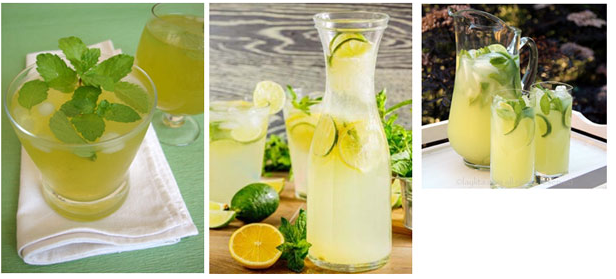
Its one of the biggest resolution people make each year – slimming down.
For a diet to receive top rating, the plan has to be nutritious, safe and effective for weight loss and preventing diabetes and hypertension.
In fact, several other top-ranked diet focuses on changing every day’s eating habits rather following a prescribed diet.
According to me, one of the best diet should be DASH known as DIETARY APPROACH TO STOP HYPERTENSION. This plan is originally designed to help control high blood pressure, focus on a healthy pattern of eating which includes lots of vegetables, whole grains and lean proteins while limiting or removing those we are grown to love like calories and fat laden sweets and red meat.
2023 is the year to go with your gut. To see headlines about eating food that protects, boosts and supports your gut. Probiotics, the friendly bacteria lives in our gut, eat a friendly diet by focusing on foods high in probiotics.
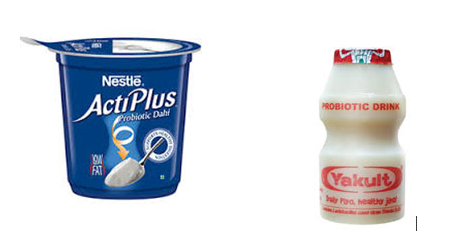
100% whole grains (other complex carbohydrates) are still having their moment. Grains like kamut, bulgur, buckwheat, quinoa, millet, amaranth and sorghum are all beneficial for health (these are full of B – vitamins and higher in fiber then refined grains or fiber.
Biodynamic! Its one of the most environmentally – friendly form of farming. Crops are free of synthetic pesticides and fertilizers and the farms are entirely self sustaining.
After DASH the second best diet would be TLC diet (Therapeutic lifestyle change) Start by choosing your target calorie level by consulting through a dietitian or a doctor. If concern is lowering LDL, the goal is 2500 per day for men and 1800 for women. Then cut saturated fat to less than 7 % of daily calories, which means eating less high – fat dairy like butter and ditching fatty meats like salami. And consume no more than dietary cholesterol a day – the amount is about 2 ounce of cheese. If after six weeks your cholesterol has not dropped by about 8 to 10 percent then add in 10 to 15 grams of soluble fiber each day. (Soluble fiber helps block the absorption of cholesterol from the digestive tract, which in turn helps lower LDL). Stanols and sterols are found in vegetable oils and certain types of margarine too. On TLC you should be eating lots for fruits, nuts, vegetables, whole grains, low fat and non fat dairy products.
Eating out: Allowed, but one has to decipher, which menu choices are the lowest in saturated fat and cholesterol. Smartest are steamed, broiled, baked, roasted or poached. Don’t be afraid to make special request for example swap fries for a salad and get the dressing on the side.
I would also like to emphasis on importance of satiety, the satisfied feeling that you have had enough. Hunger is never a problem with TLC diet, you would be eating a lot of fiber packed fruits and veggies, which quell hunger.
I feel the first thing in the morning should be, is to eat fruits. This is a time when you are empty stomach and maximum amount of nutrients will be absorbed from fruits. I would recommend 2-3 slices of papaya as it has a lot of soluble fiber and medicinal properties or 1 amla, which is also called as Indian gooseberry. One can also add few almonds or walnuts at this time.
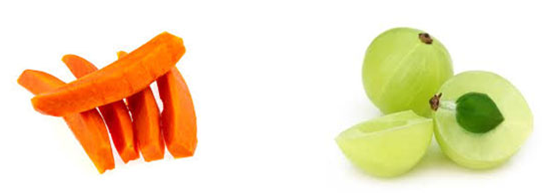
Seeds are nutritional powerhouse. But what is important is which one delivers the health benefits. I would suggest flax seeds, hemp seeds and chia seeds to be included in the diet menu for 2016. One should add 2 tea spoon on alternate days. One unique characteristic of hemp seeds is that it contains all essential amino acids. Women should consume 25 grams a day of chia seeds. Just by adding 2 tsp to oatmeal or smoothie will double the fiber intake. Flax seed meal is more beneficial then whole flax seeds. For a mid day meal, grab one fruit either apple, orange, guava or may be a green salad with green tea or lemon water.

I would even like to share that our body mechanism is such that we need food to improve the metabolism of our body. When we eat, our metabolism increases and the calories are burned. Starving sends wrong messages to our body. Another way to keep your metabolism high is by dividing three big meals into six small meals. Try to finish the last meal by 7:30 pm
An example of a perfect diet
- Start your day by 7:00 am in the morning with almonds and walnuts
- 9:00 am should be skim milk with 2 tbsp of cereal and 1 tsp of grinded flax seeds or 2 egg whites with 1 slice of multi grain bread with 1 glass of skim milk.
- 11:30 am as mid day meal should be green salad made in olive oil with black pepper or a any fruit except banana, mango.
- 1:30 – 2:00 pm Lunch – 1 chapati made from multi grain flour with 1 tbsp of veg (except for potato, alocacia, calocacia) + 1 small katori of dal
- 3:30 Post lunch – green tea with 1 orange
- 5:30 – 6:00 Evening tea – Normal tea with skim milk + 2 marie digestive biscuits
- 7:30 Dinner Vegetable stew with stir fried veg (carrot, peas, French beans, broccoli, mushrooms, kale, baby spinach leaves) OR Tomato soup with 1 tbsp of vegetable
For any Health related query, e mail us at
Info@wellnessbeyonddiet.com
You can also call us at 08427162181.
Turkish Yogurt, Egyptian Leben, American Matzoon and Indian Dahi are all similar products. Many people tend to misunderstand the difference between Curd and yogurt.
Many of my clients are under the misconception that yogurt is thicker than curd. Visiting different restaurants, I have realized that many of the chefs find it cool to write yogurt in their menu card. But curd refers to the milk solids that are left after curdling by way of adding a curdling agent that is acidic.
It could be a culture of yogurt or it could be lime-juice or vinegar. This process provides us with curd. So paneer or cottage cheese that we know is technically curd from splitting the milk and milky grey water, which is left is whey. Indian dahi is made by adding mother culture at about 30-40 C. Mother culture contains strains of lactic acid bacteria, which multiplies itself in the ambient temperature of 30-40
Yogurt is same as curd with the difference that the fermentation of the milk is done by adding 2 specific strains of bacteria called Lactobacillus Bulgaricus and streptococcus thermophillus. The addition of these bacteria makes the product standardized and homogenous. The two types of yogurt commonly found in the grocery store are set type and swiss style yogurt. Set type yogurt is when the yogurt is packed with the fruit on the bottom of the cup and yogurt on the top. Swiss style yogurt is when fruit is blended into yogurt prior to packaging.
Health Benefits of Yogurt
- Decreases ulcerative colitis symptoms
- Decreases IBS symptoms
- Decrease acute diarrhea
- Increases Immunity
Activia/Danon Yogurt
Activia contains many of the same ingredients found in regular yogurt such as lactic acid-producing bacteria, including lactobacillus bulgaricus and streptococcous thermphilus, sweetners, fruits or flavorings. It is prepared as regular or light, greek regular or lite, with added fiber or as drink.
Bifidus regularis is a probiotic specially added to Dannon yogurt to aid in digestive health. Daily consumption of yogurt with Bifidobacterium lactis improved well being and digestive symptoms in women with minor digestive problems.
For more information on seeds, e-mail the writer at info@wellnessbeyonddiet.com. She can also be contacted at 08427162181
People who are not involved in any physical activity on regular basis are prone to low back pain, especially during times when they suddenly perform stressful, unfamiliar activities.
Activities like lifting heavy items or moving them from one place to another, shoveling, digging etc. Among women, this complaint is more prevalent since they tend to lift heavy grocery bags while wearing high heels.
Lack of exercise leads to following conditions that may threaten your back
- While moving heavy items, muscles are not strong enough or fully involved in such activities and this increases the load on the spine and hence the risk of disk compression.
- People who are overweight or obese, tend to put more weight on the spine and this in turn increases pressure on the vertebrae and disk
- It has also been observed that weak stomach muscles can increase the strain on back and cause abnormal tilt of the pelvis.
- Inflexible muscles can restrict the backs ability to move, rotate and bend.
However, on the flip side of the coin improper or excessive exercise can also cause chronic back pain. To begin with, start exercising slowly, considering it a part of a broader program. Repetition is the key in increasing flexibility, building endurance and strengthening the specific muscles needed to support the spine. Few of the exercises, which are necessary in building strong muscles would be low impact aerobic exercises such as swimming, bicycling, walking, which would strengthen muscles in the abdomen without over straining the back.
Lumbar extension strength training is proving to be effective. Generally these exercises attempt to strengthen the abdomen and improve lower back mobility. They also enhance flexibility in the hip and in the tendons at the back of the thigh.
Yoga, Tai-Chi also combines low impact physical movements and meditation. They are based on the principle of disciplining the mind to achieve a physical and mental balance and can be very helpful in preventing recurrence of low back pain..
For more information on seeds, e-mail the writer at info@wellnessbeyonddiet.com. She can also be contacted at 08427162181
Today health foods are flooded in the Indian market and awareness is increasing that refined sugar is not only harmful for our waistline but also shows deleterious effect on blood sugar level.
With such negative press sugar is receiving from doctors and dietitians, I thought it is time to decipher about skin care ramifications and the results are not good.
World’s best dermatologist and skin care experts agree that a diet high in sugar is a disaster for the over all well-being of the skin. According to me, it’s a waste of your hard earned money on expensive skin care products, if you are still binging into a diet high in sugar. We can moisturize skin from outside with creams but we need to feed and stimulate the growth of strong cells from inside too and sugar will sabotage it.
The major problem with sugar is that it makes the skin lose its plump, i.e. the elastic quality, which underlies the youthful appearance. This happens due to a process called glycation. Sugar attaches itself to a protein in the body and produces harmful molecules called advanced glycation end products.
This reduces the effectiveness of elastin and collagen, major proteins in the skin that help maintain its youthful appearance. If you persistently eat a high sugar diet, then as a result collagen and elastin become more rigid, so it is easier for wrinkles to form. It also becomes tough for the cells in the skin to repair normal damage. A high sugar diet also reduces the quality of the collagen in the skin.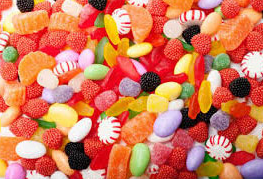
It also shows more damaging effects due to UV rays. How much one can tolerate glycation depends upon your age, metabolism and exercise regime. It has been observed that if refined sugar is cut down to quite an extend, benefits are fruitful. The skin may seem less dry within days.
Sugar also promotes inflammation and also fluctuates hormones specially in women. This depletes antioxidants and leaves the skin vulnerable to inflammation, making it more prone to acne. Hormone overdrives our skin glands resulting in excessive sebum production and skin’s cell growth. Combination of sticky sebum and dead skin results in blocked pores.
Right diet can help women stay younger. Focus on food with a low glycemic index (GI). These cause a smaller increase in your blood sugar as compared to steeper jump from food with a high glycemic index or high GI.
Eat smaller meals often. Eating every two and a half hour will help keep your blood sugar and insulin under control. Eat lots of vegetables. Choose veggies across a range of deep and bright colors. These will provide a variety of antioxidant that dampen free radical damage and inflammation.
For more information on seeds, e-mail the writer at info@wellnessbeyonddiet.com. She can also be contacted at 08427162181

